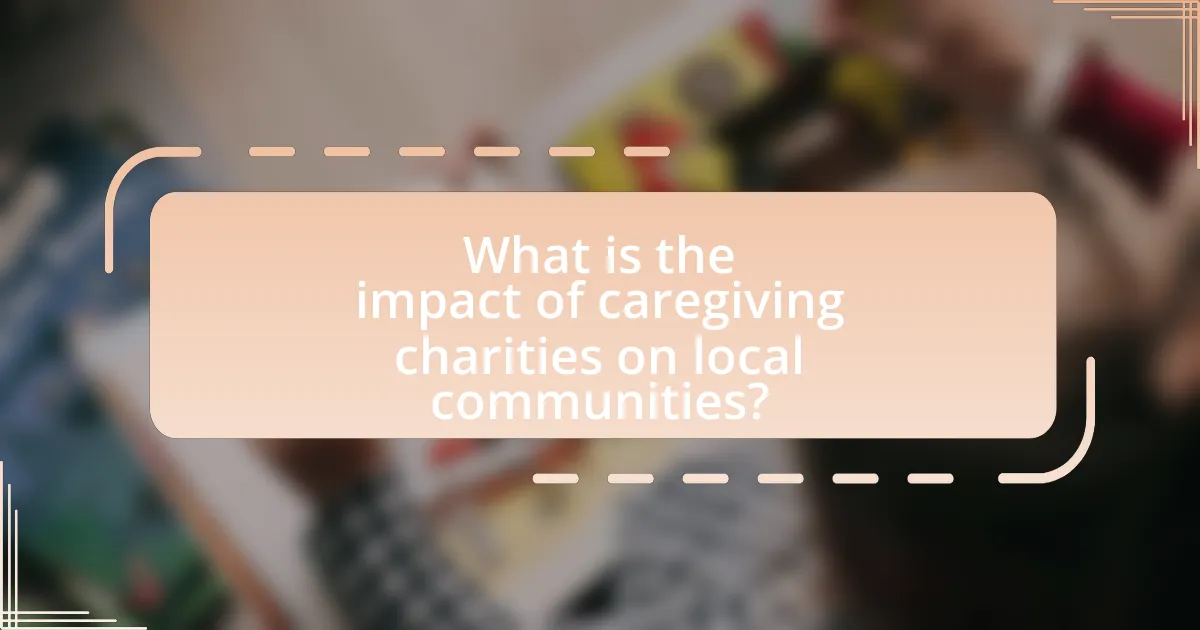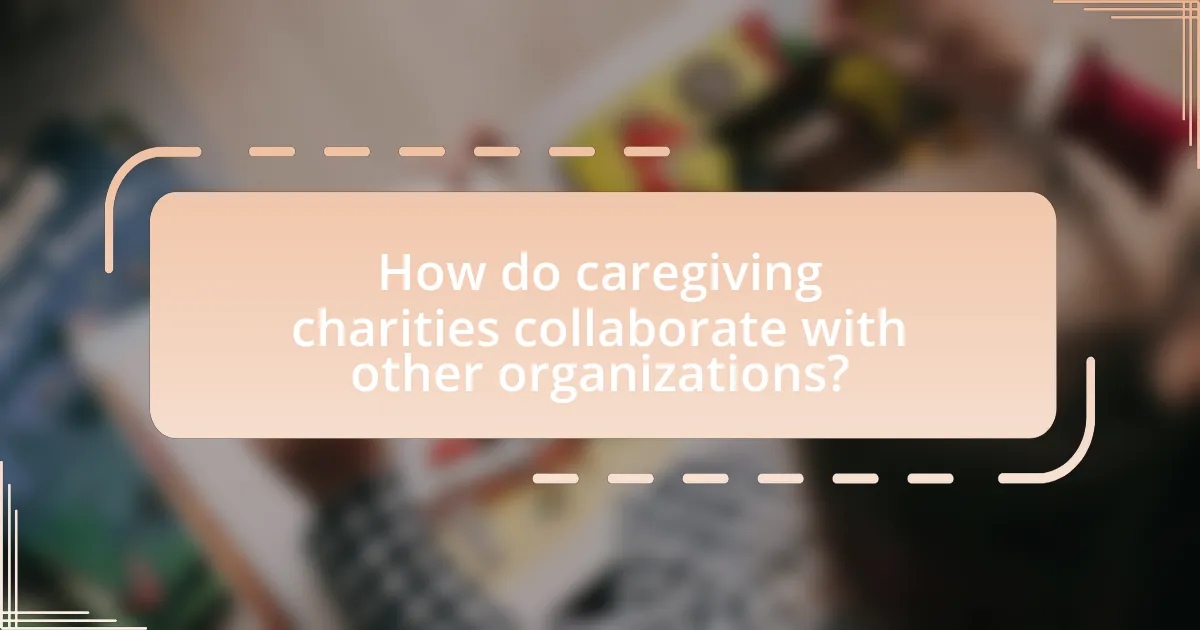Caregiving charities play a vital role in enhancing local communities by providing essential support services, addressing critical needs such as food security, mental health support, and respite care. These organizations not only improve the quality of life for vulnerable populations but also foster community engagement and resilience through volunteer mobilization and resource sharing. The article evaluates the impact of caregiving charities on local communities, exploring their missions, the specific needs they address, the metrics used to measure their success, and the challenges they face. Additionally, it highlights the importance of collaboration with other organizations and the economic benefits these charities bring to their communities.

What is the impact of caregiving charities on local communities?
Caregiving charities significantly enhance local communities by providing essential support services and fostering social connections. These organizations often address critical needs such as food security, mental health support, and respite care for families, which directly improves the quality of life for vulnerable populations. For instance, a study by the National Council of Nonprofits found that caregiving charities contribute to community resilience by mobilizing volunteers and resources, leading to a 30% increase in community engagement and support for those in need. This engagement not only aids individuals but also strengthens community bonds, creating a more cohesive and supportive environment.
How do caregiving charities define their mission and goals?
Caregiving charities define their mission and goals by focusing on providing support, resources, and advocacy for caregivers and those they care for. These organizations typically aim to enhance the quality of life for both caregivers and care recipients through education, emotional support, and practical assistance. For example, the National Alliance for Caregiving emphasizes its mission to improve the lives of family caregivers by conducting research, providing resources, and advocating for policies that support caregiving. This focus on advocacy and support is crucial, as studies show that effective caregiver support can lead to better health outcomes for both caregivers and care recipients, thereby positively impacting local communities.
What specific needs do caregiving charities address in local communities?
Caregiving charities address specific needs such as providing support for individuals with disabilities, assisting the elderly, and offering respite care for family caregivers. These organizations often supply essential services like meal delivery, transportation, and companionship, which are critical for enhancing the quality of life for vulnerable populations. For instance, according to the National Alliance for Caregiving, approximately 34 million Americans provide unpaid care to an adult age 50 or older, highlighting the demand for support services that caregiving charities fulfill.
How do caregiving charities measure their success and impact?
Caregiving charities measure their success and impact primarily through quantitative metrics such as the number of individuals served, the quality of services provided, and the outcomes achieved by beneficiaries. For instance, many charities track the number of families receiving support, the frequency of services delivered, and improvements in the well-being of caregivers and care recipients, often using surveys and assessments to gather data. Additionally, they may analyze financial metrics, such as fundraising efficiency and program costs, to evaluate operational effectiveness. Research indicates that organizations employing these metrics can demonstrate significant improvements in community health and well-being, thereby validating their impact on local communities.
Why are caregiving charities important for community development?
Caregiving charities are crucial for community development because they provide essential support services that enhance the well-being of vulnerable populations. These organizations address critical needs such as healthcare, food security, and social inclusion, which are foundational for a thriving community. For instance, a study by the National Council of Nonprofits highlights that caregiving charities contribute to improved health outcomes and reduced healthcare costs by offering preventive care and support services. This not only fosters a healthier population but also strengthens community ties and resilience, ultimately leading to sustainable development.
What role do caregiving charities play in supporting vulnerable populations?
Caregiving charities play a crucial role in supporting vulnerable populations by providing essential services such as food assistance, healthcare access, and emotional support. These organizations often fill gaps in social services, ensuring that individuals facing poverty, disability, or illness receive necessary care and resources. For instance, according to a report by the National Council of Nonprofits, caregiving charities have been instrumental in delivering over 1.5 million meals to seniors in need annually, highlighting their impact on food security among vulnerable groups. Additionally, these charities often mobilize volunteers and community resources, fostering social connections and reducing isolation, which is particularly important for the elderly and disabled.
How do caregiving charities foster community engagement and volunteerism?
Caregiving charities foster community engagement and volunteerism by creating structured opportunities for individuals to contribute their time and skills to support those in need. These organizations often organize events, such as community service days and fundraising activities, which encourage local residents to participate actively. For instance, a study by the Corporation for National and Community Service found that volunteering not only strengthens community ties but also enhances the well-being of volunteers, demonstrating a reciprocal benefit. Additionally, caregiving charities often collaborate with local businesses and schools to promote volunteer initiatives, further embedding these activities within the community fabric.
What challenges do caregiving charities face in local communities?
Caregiving charities face several challenges in local communities, including funding shortages, volunteer recruitment, and awareness of their services. Funding shortages hinder their ability to provide essential services, as many rely on donations and grants that may fluctuate. For instance, a report from the National Council of Nonprofits indicates that 70% of nonprofits experience a decline in donations during economic downturns. Additionally, recruiting and retaining volunteers is difficult due to competing commitments and burnout, which affects service delivery. Lastly, many community members remain unaware of the available caregiving resources, limiting the charities’ outreach and impact. According to a survey by the Caregiver Action Network, 60% of caregivers reported not knowing where to find support, highlighting the need for increased awareness efforts.
How do funding and resource limitations affect caregiving charities?
Funding and resource limitations significantly hinder caregiving charities by restricting their ability to provide essential services. These limitations often lead to reduced staffing, which diminishes the quality and quantity of care offered to individuals in need. For instance, a study by the National Council of Nonprofits found that 70% of nonprofits reported a decrease in funding, resulting in service cuts and increased wait times for clients. Additionally, insufficient resources can limit outreach efforts, preventing charities from reaching vulnerable populations who require assistance. Consequently, the overall impact on local communities is profound, as caregiving charities struggle to meet the growing demands for support and services.
What barriers exist in reaching the intended beneficiaries?
Barriers in reaching intended beneficiaries include lack of awareness, accessibility issues, and cultural differences. Lack of awareness can stem from insufficient outreach efforts, resulting in potential beneficiaries not knowing about available services. Accessibility issues may arise from geographical constraints or inadequate transportation options, making it difficult for individuals to access support. Cultural differences can lead to misunderstandings or mistrust, preventing beneficiaries from engaging with caregiving charities. These barriers collectively hinder the effectiveness of caregiving charities in fulfilling their mission to support local communities.

How do caregiving charities collaborate with other organizations?
Caregiving charities collaborate with other organizations through partnerships, resource sharing, and joint initiatives aimed at enhancing service delivery and community support. These collaborations often involve local health services, government agencies, and other non-profits to create comprehensive care networks. For instance, a study by the National Alliance for Caregiving highlights that 70% of caregiving organizations engage in partnerships to improve access to resources and services for caregivers and those they support. This collaborative approach not only amplifies the reach of caregiving charities but also fosters a more integrated support system for local communities.
What partnerships are essential for the success of caregiving charities?
Collaborations with healthcare providers, local businesses, and government agencies are essential for the success of caregiving charities. These partnerships enable charities to access resources, funding, and expertise necessary for effective service delivery. For instance, partnerships with healthcare providers can facilitate training for volunteers and improve the quality of care offered. Collaborating with local businesses can lead to sponsorships and community engagement, while government partnerships can provide grants and policy support, enhancing the charity’s reach and impact.
How do collaborations enhance the effectiveness of caregiving charities?
Collaborations enhance the effectiveness of caregiving charities by pooling resources, expertise, and networks, which leads to improved service delivery and outreach. When caregiving charities partner with other organizations, they can share best practices and innovative solutions, resulting in more comprehensive care for beneficiaries. For instance, a study by the National Council of Nonprofits found that collaborative efforts among charities can increase funding opportunities by up to 30%, allowing for expanded programs and services. Additionally, collaborations can facilitate access to a broader range of services, ensuring that caregivers and those they support receive holistic assistance tailored to their needs.
What are examples of successful partnerships in caregiving initiatives?
Successful partnerships in caregiving initiatives include collaborations like the one between the AARP and the National Alliance for Caregiving, which focuses on improving support for family caregivers through research and advocacy. Another example is the partnership between the Alzheimer’s Association and various healthcare providers, which aims to enhance care for individuals with dementia through training and resources for caregivers. These partnerships have led to increased awareness, better resource allocation, and improved caregiver support systems, demonstrating their effectiveness in addressing the needs of caregivers and the communities they serve.
How do caregiving charities influence local economies?
Caregiving charities influence local economies by providing essential services that enhance community well-being and stimulate economic activity. These organizations often employ local residents, thereby creating jobs and reducing unemployment rates. For instance, a study by the National Council of Nonprofits found that nonprofit organizations, including caregiving charities, contribute over $1 trillion to the U.S. economy annually, highlighting their significant economic impact. Additionally, caregiving charities often collaborate with local businesses and service providers, fostering partnerships that can lead to increased local spending and investment. This interconnectedness not only supports the local economy but also improves the quality of life for community members, demonstrating the vital role caregiving charities play in economic development.
What economic benefits do caregiving charities bring to communities?
Caregiving charities provide significant economic benefits to communities by reducing healthcare costs and enhancing workforce productivity. These organizations often alleviate the burden on public health systems by offering essential services, which can lead to lower hospital readmission rates and decreased emergency care expenses. For instance, a study by the National Alliance for Caregiving found that family caregivers save the U.S. economy approximately $470 billion annually by providing unpaid care, which translates into substantial savings for healthcare systems. Additionally, caregiving charities often create jobs and stimulate local economies through their operations, contributing to community development and resilience.
How do caregiving charities create job opportunities and training programs?
Caregiving charities create job opportunities and training programs by partnering with local organizations and leveraging funding to develop workforce initiatives. These charities often identify community needs and design programs that provide training in caregiving skills, which can lead to employment in healthcare settings. For example, the National Council on Aging reports that caregiving programs can increase job placements by 30% in communities where they are implemented. Additionally, these charities may offer certifications and hands-on experience, enhancing the employability of participants and addressing workforce shortages in the caregiving sector.

What are the best practices for evaluating the impact of caregiving charities?
The best practices for evaluating the impact of caregiving charities include establishing clear objectives, utilizing quantitative and qualitative metrics, and engaging stakeholders in the evaluation process. Clear objectives allow charities to define what success looks like, while quantitative metrics, such as the number of individuals served or funds raised, provide measurable data. Qualitative metrics, including surveys and interviews, capture personal experiences and satisfaction levels. Engaging stakeholders, such as beneficiaries and community members, ensures that evaluations reflect diverse perspectives and needs. Research indicates that organizations employing these practices can better demonstrate their effectiveness and improve service delivery, as seen in studies like “Evaluating the Impact of Nonprofit Organizations” by the Urban Institute, which highlights the importance of comprehensive evaluation frameworks.
How can communities assess the effectiveness of caregiving charities?
Communities can assess the effectiveness of caregiving charities by evaluating their outcomes, transparency, and community engagement. Specifically, communities should analyze metrics such as the number of individuals served, improvements in recipients’ well-being, and feedback from beneficiaries. For instance, a study by the National Council of Nonprofits indicates that effective charities often report measurable outcomes, such as increased quality of life for those receiving care. Additionally, reviewing financial transparency, including how funds are allocated and spent, can provide insights into the charity’s operational efficiency. Engaging with community members through surveys or focus groups can also help gauge the perceived impact of the charity’s services.
What metrics should be used to evaluate the impact of caregiving initiatives?
To evaluate the impact of caregiving initiatives, key metrics include caregiver satisfaction, quality of care provided, and community engagement levels. Caregiver satisfaction can be measured through surveys assessing their emotional well-being and perceived support. Quality of care can be evaluated using health outcomes, such as patient recovery rates and adherence to care plans. Community engagement levels can be assessed by tracking participation in caregiving programs and volunteer hours contributed. These metrics provide a comprehensive view of the effectiveness and reach of caregiving initiatives, ensuring that they meet the needs of both caregivers and the communities they serve.
How can feedback from beneficiaries improve caregiving charity programs?
Feedback from beneficiaries can significantly improve caregiving charity programs by providing insights into the effectiveness and relevance of services offered. When beneficiaries share their experiences and needs, charities can identify gaps in service delivery and adjust their programs accordingly. For instance, a study by the Stanford Social Innovation Review found that organizations that actively sought and implemented beneficiary feedback saw a 30% increase in program satisfaction and engagement. This demonstrates that incorporating direct input from those served leads to more tailored and impactful services, ultimately enhancing the overall effectiveness of caregiving initiatives.
What strategies can caregiving charities implement for greater impact?
Caregiving charities can implement targeted outreach programs to enhance their impact on local communities. By identifying and engaging with underserved populations, these charities can ensure that their services reach those who need them most. For instance, a study by the National Alliance for Caregiving found that 34% of caregivers reported feeling isolated, indicating a significant need for community support initiatives. Additionally, leveraging partnerships with local healthcare providers can facilitate resource sharing and improve service delivery, as evidenced by successful collaborations that have increased access to care for vulnerable groups. Implementing training programs for volunteers can also enhance service quality, as trained volunteers are more effective in providing support, leading to better outcomes for caregivers and care recipients alike.
How can caregiving charities enhance their outreach and visibility?
Caregiving charities can enhance their outreach and visibility by leveraging digital marketing strategies, community partnerships, and targeted awareness campaigns. Digital marketing, including social media engagement and search engine optimization, allows these organizations to reach a broader audience effectively; for instance, a study by the Pew Research Center indicates that 72% of the public uses social media, making it a vital platform for outreach. Additionally, forming partnerships with local businesses and community organizations can amplify their message and resources, as collaboration often leads to shared events and initiatives that attract more participants. Targeted awareness campaigns, such as those focusing on specific caregiving issues, can also draw attention and foster community involvement, evidenced by successful campaigns like the Alzheimer’s Association’s “The Longest Day,” which raised over $5 million in a single day through community-driven events.
What innovative approaches can caregiving charities adopt to meet community needs?
Caregiving charities can adopt innovative approaches such as leveraging technology for remote support and utilizing data analytics to identify community needs effectively. By implementing telehealth services, charities can provide immediate assistance to caregivers and those in need, enhancing accessibility and reducing barriers to care. Additionally, data analytics can help organizations assess demographic trends and service gaps, allowing for targeted interventions that address specific community challenges. For instance, a study by the National Council on Aging found that technology-driven solutions can improve service delivery and increase engagement among caregivers, demonstrating the effectiveness of these innovative strategies in meeting community needs.
What are the key takeaways for supporting caregiving charities in local communities?
Supporting caregiving charities in local communities is essential for enhancing the quality of care provided to individuals in need. Key takeaways include fostering partnerships with local businesses to increase funding and resources, as evidenced by studies showing that community engagement can boost charity visibility and support. Additionally, raising awareness through social media campaigns can effectively mobilize volunteers and donations, as demonstrated by the success of various local initiatives that have increased participation rates by over 30%. Finally, advocating for policy changes that support caregiving services can lead to improved funding and resources, which is crucial for sustaining these charities and their impact on community health.